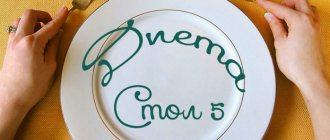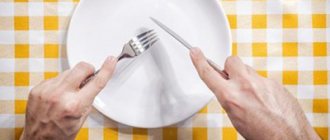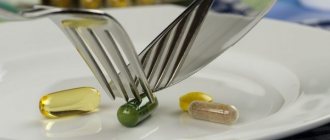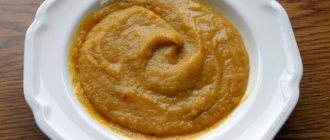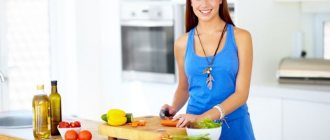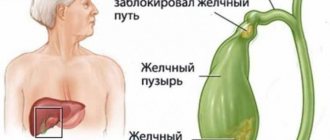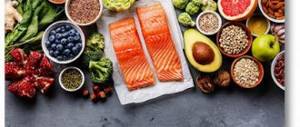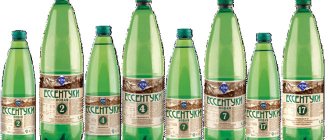Basic principles of proper nutrition for a diseased liver
The diet for liver diseases has several general rules aimed at reducing the load on the organ and cleaning it. The basis of nutrition is an increase in easily digestible protein, a large amount of fiber, a vitamin and mineral complex. An additional condition is to reduce in the diet foods that increase the secretion of digestive juice. Dietary nutrition for the liver is based on the following principles:
- Multiple meals in small portions.
- Products should be ground or boiled so that the liver is less stressed.
- Nutrition should not be based on fried, hot and cold foods. Food is taken only warm.
Permitted and prohibited products
The liver diet is based on dividing foods into permitted and prohibited. Here are the foods you can eat if you have liver problems:
- Lean fish and meat, stewed or steamed.
- Dairy and fermented milk products, except fermented baked milk, cream and sour cream.
- Bread only with coarse flour.
- Seafood.
- Vegetables, only boiled, stewed or baked. The same goes for fruits, which can be eaten raw, but in small quantities.
- Soups based on cereals, vegetables or dairy, most importantly - without strong meat or mushroom broth.
- Sweets in the form of marshmallows, marmalade, jam, jelly or honey.
- Cereals: semolina, oatmeal, buckwheat, rice.
- Non-acidic berries.
- Non-acidic jelly, juice or compote.
- Vegetable oil, butter.
- Boiled egg whites, scrambled eggs, whole eggs up to 2 per week.
- Among meat food products for treatment, it is better to give preference to chicken, veal and beef,
- Fish: cod, perch, pike perch, navaga.
Rules for drawing up a treatment menu
A diet for liver diseases also cleanses it, so the diet must contain a certain amount of essential substances:
- At least 90 g of proteins, half of which are animal and vegetable.
- From 80 to 90 g of fat, a third of which is vegetable.
- Up to 500 g of carbohydrates, with no more than 100 g allocated for simple carbohydrates.
- From 1.5 to 2 liters of liquid, i.e. pure water excluding broths, juices and other drinks.
- The amount of table salt is no more than 10 g.
- 2400 to 2800 calories.
Nutrition for chronic pancreatitis and cholecystitis
Only a doctor can tell you which diet for pancreatitis and cholecystitis is most effective and safe for each case individually. As standard recommendations, “Table No. 5” is prescribed, which includes the use of gentle food products with a reduced content of carbohydrates and fats.
The total calorie content of all dishes is from 2,600 to 2,800 kcal per day, which includes:
- proteins - 120 g;
- vegetable fats – 15 g;
- animal fats – 65 g;
- carbohydrates – 400 g.
However, you should not consume more than 1 tbsp of sugar. l. per day, salt - no more than 10 g and liquid not less than 2.5 liters.
Dietary table No. 5 for the liver, pancreas and gall bladder
Diet number 5 involves a gentle diet for the gallbladder, liver and pancreas and helps restore their functions. The main thing is that the patient does not suffer from pathologies associated with the stomach or intestines. Special diet No. 5 is indicated:
- with chronic cholecystitis and hepatitis or during their exacerbation;
- for chronic cholelithiasis;
- with cirrhosis or fibrosis of the liver;
- with liver hepatosis or fatty steatosis;
- with diffuse changes in liver tissue;
- after liver resection or surgery to remove the gallbladder;
- with metastases in the liver;
- for liver cancer;
- for liver disease from infectious inflammation;
- with a cyst or fatty liver;
- with an enlarged liver.
Sample menu for the week
Monday:
- breakfast – rice milk porridge, white of one egg;
- second breakfast – cottage cheese casserole;
- lunch - cabbage soup, boiled meat with stewed carrots;
- afternoon snack – biscuit cookies;
- dinner - macaroni and cheese.
Tuesday:
- breakfast – apple and carrot salad, meat cutlet;
- second breakfast - apple;
- lunch – stewed cabbage, mashed potato soup, steamed fish;
- afternoon snack - biscuit;
- dinner – buckwheat-based casserole.
Wednesday:
- breakfast - omelet, milk oatmeal;
- second breakfast – baked apple;
- lunch – boiled chicken and rice with milk sauce, vegetable soup;
- afternoon snack – freshly squeezed juice;
- dinner - mashed potatoes, stewed fish.
Thursday:
- breakfast – cottage cheese with honey;
- second breakfast - boiled pasta with butter;
- lunch – cabbage rolls, vegetable soup;
- afternoon snack - kefir;
- dinner – rice porridge with milk.
Friday:
- breakfast – buckwheat with butter, a little cottage cheese;
- second breakfast – carrot puree;
- lunch – vegetable borscht, steamed cutlets with noodles;
- afternoon snack - any permitted fruit;
- dinner - mashed potatoes, vegetable salad, stewed fish.
Saturday:
- breakfast - milk oatmeal, boiled egg;
- second breakfast – baked apple;
- lunch – milk soup, cottage cheese casserole;
- afternoon snack – juice, biscuits;
- dinner – semolina porridge with prunes.
Sunday:
- breakfast – salad with vegetable oil dressing;
- second breakfast – cottage cheese casserole;
- lunch - soup without meat, noodles with boiled meat;
- afternoon snack - apple;
- dinner – cottage cheese dumplings.
Menu (Power Mode)
Monday
| Breakfast | Oatmeal with milk diluted with water, weak tea with crackers |
| Lunch | Baked apples with cottage cheese |
| Dinner | Vegetable-based soup, boiled chicken breast, beet salad, rosehip infusion |
| Afternoon snack | Baked pear |
| Dinner | Pasta with boiled fish, jelly |
| Before bedtime | A glass of kefir |
Tuesday
| Breakfast | Steam omelet (from egg whites), weak tea, cracker |
| Lunch | Apple (non-sour variety) |
| Dinner | Vegetable soup, stewed vegetables with boiled fish, compote |
| Afternoon snack | Banana |
| Dinner | Rice casserole with vegetables, steamed meatballs, compote |
| Before bedtime | A glass of milk with reduced fat content |
| Breakfast | Steamed cheesecakes, a glass of tea with milk |
| Lunch | Compote with biscuits |
| Dinner | Rice soup, stewed carrots with steam cutlets, berry compote |
| Afternoon snack | Fruit jelly |
| Dinner | Baked vegetables with boiled chicken breast, jelly |
| Before bedtime | A glass of kefir |
Thursday
| Breakfast | Curd casserole, weak tea |
| Lunch | Oatmeal jelly with biscuits |
| Dinner | Vegetable soup, buckwheat porridge with steamed cutlets, compote |
| Afternoon snack | Fruit salad |
| Dinner | Mashed potatoes with boiled breast, weak tea |
| Before bedtime | Glass of fermented baked milk |
Friday
| Breakfast | Oatmeal jelly with biscuits |
| Lunch | Crackers with tea |
| Dinner | Soup with meatballs, buckwheat porridge with steamed cutlets, jelly |
| Afternoon snack | Cottage cheese with low fat content |
| Dinner | Fish casserole with stewed vegetables, compote |
| Before bedtime | A glass of milk |
Saturday
| Breakfast | Oatmeal, weak tea |
| Lunch | Low fat cottage cheese, baked apple |
| Dinner | Pumpkin soup, noodles with boiled meat, berry compote |
| Afternoon snack | Banana |
| Dinner | Rice with dried fruits, jelly |
| Before bedtime | Glass of fermented baked milk |
Sunday
| Breakfast | Rice pudding with berries or fruits, weak tea |
| Lunch | Fruit salad |
| Dinner | Vegetable soup, pasta with boiled meat, compote |
| Afternoon snack | Tea with milk and biscuits |
| Dinner | Mashed potatoes with fish cutlets, jelly |
| Before bedtime | A glass of kefir |
https://www.youtube.com/watch?v=LR9VDEybB50
A diet for liver diseases also cleanses it, so the diet must contain a certain amount of essential substances:
- At least 90 g of proteins, half of which are animal and vegetable.
- From 80 to 90 g of fat, a third of which is vegetable.
- Up to 500 g of carbohydrates, with no more than 100 g allocated for simple carbohydrates.
- From 1.5 to 2 liters of liquid, i.e. pure water excluding broths, juices and other drinks.
- The amount of table salt is no more than 10 g.
- 2400 to 2800 calories.
Changing your diet, eating fast food that contains large quantities of fats and light carbohydrates, increasing stress load - all this serves as a background for the appearance of diseases of the gastrointestinal tract. These diseases, to varying degrees, worsen the quality of life of patients, and it is comparable to that for diseases of the cardiovascular system.
During treatment, much attention is paid to dietary nutrition, the role of which is especially significant in this pathology. Table No. 5 is a universal basic diet used for diseases of the gastrointestinal tract. Varieties have been created on its basis, which makes it possible, with some correction, to use it for diseases of the liver, pancreas, gallbladder and ducts, when they are combined with colitis and gastritis, as well as after liver surgery.
The diet for diseases of the liver and pancreas should be gentle, therefore chemical and mechanical irritants are excluded or sharply limited (depending on the stage of the process). Disease of the liver and pancreas requires a diet; food intake should be small and small, and the food itself should be warm. Eating cold or hot foods is not allowed.
The general principles of nutrition for the pathology of these organs are:
- Exclusion from the diet of strong chemical irritants: essential oils of plants (onion, garlic, celery, radish, radish) and extractive substances (broths), dried and smoked foods, fried foods. To extract extractive substances, which is especially important for pancreatitis, meat is cooked in small pieces, draining the water, and only then used as a semi-finished product for various dishes.
- Elimination of mechanical irritants in the form of coarse meats, fresh vegetables with coarse fiber and unprocessed foods.
- Eliminate the frying method when cooking. Dishes are prepared boiled or steamed. Baking without a crust is possible only with liver diseases in remission.
- A reduced amount of fats (refractory and poorly digestible ones are limited), vegetable oils are introduced, but in limited quantities for pancreatitis and calculous cholecystitis.
- Limiting foods rich in purines: animal liver, meat of young animals and birds, yeast, sardines, tuna, sprats, herring, salmon caviar, salmon, shrimp, mussels, squid, dried porcini mushrooms, smoked eel.
- Limiting table salt (up to 6 g) and egg yolks.
- Introduction of lipotropic substances that protect the liver from fatty degeneration. They are found in beef, lean fish, low-fat cottage cheese, seafood, whey, buttermilk, buckwheat and soy flour.
- Small meals with frequent meals. This promotes the regular flow of bile and pancreatic enzymes.
- Dishes are wiped or chopped during an exacerbation and in cases of severe inflammation.
During an exacerbation, nutrition should create maximum peace and help eliminate pain, so food is given pureed and liquid. The principle of small and frequent meals must also be observed, this is especially important for pancreatitis, when meals reach up to 8 times a day in small portions (50-100 g each).
For this disease, a low-calorie diet containing 60 g of protein and 50 g of fat is first prescribed. The diet consists of boiled foods of a semi-liquid consistency and mainly carbohydrate foods (decoctions of cereals, weak tea with sugar, pureed liquid porridges, pureed compotes, crackers, jelly and jelly with xylitol).
Protein products are gradually introduced: curd puddings, calcined cottage cheese in the form of paste, steamed omelet from 1-2 eggs, cream soup from boiled meat, meat and fish soufflé, steamed cutlets from lean meat. If well tolerated, add butter, pureed vegetable soups and vegetable puree (potato, carrot, beetroot). All dishes are prepared boiled or steamed. At first they are thoroughly wiped, and then crushed.
Nutrition during the acute period of liver disease is organized within Table No. 5A, and it is more varied than during exacerbation of pancreatitis:
- Steamed dishes made from twisted meat and lean fish.
- Puree or chopped boiled vegetables (potatoes, pumpkin, carrots, cauliflower and beets).
- Reduced amount of refractory fats and salt.
- Soups made with vegetable broths with pureed cereals and vegetables, puree soups seasoned with butter or cream.
- Porridges: semolina, buckwheat, rice, oatmeal, boiled in water and ground to a semi-liquid consistency. Vegetable oil is added to dishes if it is well tolerated.
- Bold cottage cheese, low-fat fermented milk products.
- Protein omelettes.
- Ripe, sweet fruits, baked and boiled, raw - only pureed.
During the recovery period, nutrition during the treatment of a diseased liver and pancreas is balanced and contains 90 g of proteins, 400 g of carbohydrates and fats - 80 g. However, the pathology of the pancreas requires adjustments and the nutrition of such patients is organized within Table No. 5P.
With chronic pancreatitis, exocrine insufficiency of the gland develops over time, which manifests itself in insufficient production of digestive enzymes. They are involved in the breakdown and digestion of carbohydrates, fats and proteins. Indigestion is manifested by signs of malnutrition in patients: weight loss and weight deficiency. Patients also develop undigested fat in their stool (steatorrhea).
In this regard, a complete diet is recommended, so the amount of protein is increased to 120-150 g (of which animal proteins should be 80-85%), and the fat content is reduced to 70 g and below (depending on their tolerance). Refractory fats are poorly tolerated by patients - they increase abdominal pain, cause diarrhea and support inflammation, so their amount is significantly reduced, and the diet is enriched with vegetable oils.
Simple carbohydrates are also limited. This is due to the fact that Langerhans cells, which produce insulin, are involved in the process. Ultimately, this can lead to insulin deficiency and the development of diabetes. Limiting or eliminating easily digestible carbohydrates (confectionery, white bread, semolina, sugar and sweets, potatoes, rice and oatmeal) serves as a prevention of diabetes.
At the same time, correction of enzyme imbalance is carried out with the prescription of enzyme preparations. Diet and enzyme replacement therapy prevent the progression of fibrodegenerative changes in the gland, they reduce pain and correct digestive disorders.
Taking enzyme preparations and maintaining proper nutrition should continue for years. Reducing dyspeptic syndrome and stabilizing weight are not indications for discontinuing enzyme therapy, since most patients, even with normal weight, have a nutritional disorder, as well as micronutrient deficiency.
The diet uses foods that inhibit pancreatic enzymes: egg whites, potatoes, soybeans, oatmeal. The amount of fat is increased gradually from 50 g to 70 g, observing their tolerance. You should not consume foods with a juice effect: any broths, fried foods and alcoholic beverages.
The list of products expands during the period of remission, when the inclusion of raw vegetables and fruits is allowed. Soups can be consumed raw, and new first courses can be carefully introduced into the diet: beetroot soup, borscht and cabbage soup. The following remain contraindicated: coffee, cocoa and carbonated drinks.
Fasting days are indicated for many diseases, including pancreatitis. This kind of mono-diet allows the gastrointestinal tract to work in a gentle manner. Since fasting diets are deficient in chemical composition, they can be prescribed only for 1 day and once a week or less often for patients with pancreatitis with low nutrition.
Recipes for dietary dishes to restore the liver
The first recipe that is good for the liver is a puree soup based on pumpkin and oatmeal:
- Cook 100 g of peeled and diced pumpkin until half cooked.
- Place the pumpkin in a deep frying pan, add 2 tbsp. l. oatmeal, 0.5 tsp. butter, a little pumpkin broth.
- Simmer covered for another half hour, then grind everything in a blender, add a little sugar, and also pumpkin broth.
Steamed beef cutlets:
- Make minced meat from 150 g of beef and 30 g of stale white bread soaked in milk using a meat grinder/blender.
- Add salt and dilute with water.
- Form cutlets and steam for about half an hour.
Egg white sponge cake:
- Mix 6 egg whites with 1/3 cup sugar and beat.
- Add 1 cup of crushed white bread croutons into the resulting foam.
- First pour half of the mixture into the greased form, sprinkle with 1-2 tbsp. l. poppy seeds, and then the remaining half.
- Bake in the oven at 180°C.
Video: therapeutic nutrition for liver cirrhosis
The diet for hepatitis C, cancer or cirrhosis of the liver requires general nutritional rules, but there are some differences for each disease. They relate to the list of allowed/prohibited foods, daily calorie content, and the composition of the diet for 1 day. To learn about the nuances of nutrition for liver cirrhosis, watch the useful video below and create your own menu.
Everything in the human body is interconnected, and when a pathology occurs in one organ, the functioning of the entire organism is often disrupted. So, it happens with liver disease, namely with its inflammation - hepatitis. This disease entails disease of the gallbladder and pancreas, thereby causing discomfort to the person.
In this case, a person should follow a strict diet, which will promote rapid recovery and recovery. We will tell you how to eat properly with this pathology in this article.
Diet for cholecystitis with pancreatitis
People suffering from this disease must eat properly. Fats should be eliminated from the diet as much as possible, replacing them with carbohydrates, thereby increasing the calorie content of food intake. A prerequisite for following a diet is to drink plenty of fluids. You should drink at least two liters of water per day.
If a person has severe nausea, then water and food intake should be limited to small portions, and medications should be taken for rehydration. Drinking mineral water will help to avoid disturbances in the water-electrolyte balance in the body. Food should only be taken when heated to a warm state (40–45 degrees Celsius).
Features of the diet during the acute phase of the disease
What can you eat for cholecystitis and pancreatitis at the acute stage? At this stage, for the first 2-3 days it is best to refuse food altogether and only drink pure mineral water or rosehip decoction. The amount of liquid per day should not exceed a liter.
Over the next few days, doctors allow you to drink warm tea with toast, pureed soup, milk porridge, and a protein omelet made in a double boiler.
After a week, the diet can be supplemented with low-fat unleavened cottage cheese, vegetable broths or side dishes, for example, potatoes, carrots and beets.
At about 9-10 days, you can add white meat and fish, cooked in a double boiler, as well as dietary cutlets and meatballs to the menu.
The therapeutic diet should be followed for 8–12 months until a stable period of remission and a stable condition are achieved.
Advantages and disadvantages
The diet has undeniable advantages, they look like this:
- Helps prevent exacerbation of chronic diseases, and also improves overall health.
- Improves the functioning of the pancreas and gall bladder.
- Normalizes blood cholesterol levels.
- The diet is physiologically balanced.
- Easy to tolerate by the body.
- Not expensive in terms of buying food.
Among the disadvantages are the following:
- Very long-term (to normalize your general condition, you can go on a diet for years).
- Separate preparation of various dishes, which requires culinary skills, abilities and time.
Features of diet for chronic pathologies
A special diet recommended for such a disease is necessary to restore normal activity of the pancreas and gall bladder. In this case, the patient is prohibited from eating foods that lead to increased production of bile and other enzymes. These include fried, salty, fatty, smoked foods, as well as alcohol and soda. You should completely avoid fast food and quick dry snacks.
In the chronic course of pathologies, it is very important to avoid overeating, which leads to increased stress on damaged organs. The quality of food is also considered equally important: all products must be fresh, and dishes must only be cooked.
Food that is difficult for the stomach to process should be excluded from the diet - it increases the production of digestive enzymes and contributes to the appearance of gases.
The daily menu for each patient is selected individually, depending on the severity of the pathology and the characteristics of the body. But in all cases, nutrition should be rational, moderate in calories and balanced.
What foods are included in the diet, what can you eat?
If you decide to go on a diet, then you need to know what foods to eat. These include:
- Boiled eggs or omelet (no more than two per week).
- Vegetable and butter.
- Compote, juice or jelly.
- Various berries (not sour).
- Various cereals: rice, buckwheat, oatmeal, semolina.
- Sweet products: honey, jelly, jam, marmalade or pastille.
- Dairy, vegetable or cereal-based soups.
- Fruits (in small quantities).
- Baked, stewed or boiled vegetables.
- All kinds of seafood.
- Bread made from coarse flour.
- Fermented milk and dairy products (except for sour cream, cream and fermented baked milk).
- Steamed or stewed beef, veal and chicken.
- Stewed or boiled fish (navaga, pike perch, cod perch).
How to eat
diet for chronic pancreatitis during exacerbation
The main goal of the diet during exacerbation of chronic pancreatitis is to minimize the load on the diseased organ. A gentle regime is created only by those products that do not contain fats. Their use allows you to avoid stomach injury.
IMPORTANT: During the treatment of chronic pancreatitis, a person is required to consume as much animal protein as possible. The amount of fats and carbohydrates should be minimized.
What to eat during an exacerbation
Protein nutrition for pancreatitis during an exacerbation helps to resuscitate damaged organ tissue.
First you need to provide the body with the amount of calcium it needs. This accompanies the strengthening of vascular walls and a decrease in their permeability. It is recommended to limit salt intake. This will help relieve swelling of the organ. You can restore the digestive system with the help of bioflavonoids, as well as vitamins B, C, A.
what to eat during exacerbation of pancreatitis
When the disease makes itself felt, you need to eat thoroughly pureed, steamed food. Diet during exacerbation of pancreatitis excludes the use of seasonings and spices. The patient can eat:
- Liquid warm soups.
- Semolina, rice, oatmeal porridge.
- Vegetable puree.
- Whipped cottage cheese.
It is best to drink weak tea without sugar.
Over time, the diet expands. After 7-10 days, the diet for pancreatitis in the acute stage allows you to eat boiled river fish, chicken, turkey, and beef.
Overeating should not be allowed. Therefore, meals during exacerbation of pancreatitis should be fractional. It is important to observe the time interval between meals. It lasts 2-3 hours.
Nutrition during a fading exacerbation
The diet for chronic pancreatitis during the attenuation of the exacerbation stage pursues the goal of biochemical and mechanical sparing of the mucous membrane. Therapeutic nutrition includes:
- control of the level of carbohydrates, lipids, proteins;
- exclusion of spices, smoked meats, spicy foods;
- consumption of water-soluble vitamins;
- exclusion of seasonings;
- use of fat-soluble vitamins.
The diet for the attenuation of exacerbation of chronic pancreatitis allows the consumption of small pieces of food. The temperature of the food should not exceed 60 degrees. It is advisable to eat no more than 6 times a day.
The content of a daily serving of protein varies from 40 to 90 g, fat - from 30 to 80 g, carbohydrates - from 60 to 300 g. Calorie content should not exceed 2.5 thousand kcal.
During the attenuation of the exacerbation, it is allowed to eat vegetable puddings. It is permissible to drink juices and tea with a small amount of sugar. Before lights out, you can drink a little low-fat kefir, fermented baked milk or yogurt.
The diet for the attenuation of exacerbation of pancreatitis is followed for 12 months. Errors in nutrition should not be allowed.
What to eat after an exacerbation
nutrition for pancreatitis during an exacerbation
It is important to know what you can eat if you have pancreatitis after an exacerbation. The main goal of the diet is to reduce the risk of relapse. It is allowed to bake food in the oven. The amount of fat should be kept to a minimum.
Diet after exacerbation of pancreatitis involves the use of:
- cream soups;
- well-cooked pasta;
- thoroughly pureed cereals;
- rabbit meat;
- river fish;
- non-acidic fresh milk;
- peeled and heat-treated fruits;
- jelly, jelly;
- dried fruits
It is recommended to drink non-acidic warm compotes. It is best to cook them from green apples.
The content of a daily serving of protein varies from 50 to 120 g, fat - from 30 to 90 g, carbohydrates - from 40 to 350 g. The energy value should not exceed 2.7 thousand kcal. The amount of protein may be slightly more than the physiological norm.
Commentary on prohibited products
Diet during exacerbation of pancreatitis of the pancreas excludes the use of fresh baked goods. You can't eat white wheat bread. Lard is strictly prohibited. This product negatively affects not only the pancreas, but also the liver.
The consumption of pork and lamb is excluded. Sausages and smoked meats should not be eaten even when remission occurs. When following a diet during exacerbation of pancreatitis, you need to exclude pickled and salty products from the menu. Doctors prohibit eating even those cucumbers and tomatoes that were prepared at home.
It is important to avoid acidic foods, animal fat, and foods that cause flatulence. A person following a diet during exacerbation of chronic pancreatitis must exclude fatty milk and rich broths from the menu.
Prohibited Products
In order not to aggravate the course of the disease, you should refrain from the following foods:
- Alcohol, coffee, carbonated and sour drinks (including compotes and juices).
- Canned, spicy and smoked foods.
- Fish, meat and mushroom broths.
- Salted, dried and fatty fish (carp, salmon, catfish, etc.).
- Duck and goose meat.
- Sour fruits and berries, as well as raw vegetables (lemon, spinach, peppers, garlic, green onions, sauerkraut,
- tomatoes, sorrel, etc.).
- Barley and corn grits, as well as all types of legumes.
- Soups: cold okroshka, borscht with meat broth, green cabbage soup.
- Fried eggs.
- All kinds of confectionery products containing cocoa, as well as buns, pastries and cakes.
| Allowed | Forbidden |
| Stale bread, a day old, oatmeal cookies, honey, crackers, marmalade, marshmallows | Fresh bread, muffins, puff pastries, pies and other baked goods |
| Soups made from vegetables, cereals and thin noodles | Steep broths with fatty meat and fish, borscht, okroshka |
| Meat that does not contain fat: chicken, veal, sea fish, rabbit, turkey | Fatty beef, pork, duck, dumplings, cod liver |
| Homemade cottage cheese, yogurt, goat milk | Sausages, frankfurters, sausages, smoked meats |
| Omelet from chicken eggs without yolk, quail eggs | Pickles, marinades, sauerkraut, peppers |
| Buckwheat, semolina, oat flakes, rice | Condensed milk, confectionery, jams, different types of ice cream |
| Zucchini, potatoes, sea cabbage, dill, beets | All legumes |
| Non-acidic fruits of fruit and berry plants, dried fruits; from nuts: almonds, hazelnuts, groundnuts (peanuts) | Spicy snacks, vegetables, sour fruits, including cherries |
| Lightly brewed warm tea, rosehip decoction, Borjomi, Essentuki-4, fresh homemade juices | Alcohol of any strength and sparkling water, steeply brewed tea, cocoa, coffee |
Basics of diet for cholecystitis with pancreatitis
These diseases can manifest themselves due to various reasons: heredity, environmental pollution, smoking, drinking alcohol, self-medicating various diseases, eating unhealthy and heavy foods, entering the body with pathogenic infections, etc. Such pathologies can be treated in various ways, but the main thing is This is to follow certain rules for eating food, which is included in diet No. 5.
Gentle diet option No. 5
| Day of the week | Morning meal | Lunch | Dinner | Dinner | Last meal one to two hours before bedtime |
| Monday | Steamed curd soufflé | Lean meat soufflé | Chicken soufflé, pureed vegetable soup | Vegetable puree, boiled fish | A glass of fermented baked milk or kefir |
| Tuesday | Rice milk porridge, tea | Chicken fillet soufflé | Vegetable soup, boiled pasta, steam cutlets | Carrot puree, chicken cutlets | A glass of fermented baked milk or kefir |
| Wednesday | Steam omelette without yolks | A cup of homemade cottage cheese | Vermicelli soup without meat, vegetable stew | Dietary cottage cheese pudding | Curdled milk |
| Thursday | Hercules milk porridge | Meat soufflé | Meatless soup with cereal, a portion of boiled meat, vegetable puree | Pasta casserole with cottage cheese | A glass of kefir |
| Friday | Milk semolina porridge | Chicken fillet soufflé | Puree vegetable soup, potato casserole and boiled minced meat | Protein omelet | A glass of fermented baked milk or kefir |
| Saturday | Cottage cheese pudding | Sandwich of toasted white bread and cheese, tea | Vegetable soup without meat, a portion of boiled meat with rice | Carrot puree, meatballs | Cup "Snowball" |
| Sunday | Milk oatmeal | A glass of fermented baked milk or yogurt without fillers | Vegetable soup, portion of chicken meatballs, vegetable puree | Diet meatloaf | Kefir or fermented baked milk |
Rules for drawing up a treatment menu
Diet No. 5 involves eating foods that do not have a pronounced taste and do not contain fat. Dishes are prepared by stewing, steaming or boiling. Products are consumed in small portions with a frequency of five to six times a day. Starving and overeating is strictly prohibited.
The diet must comply with the following standards:
- The energy value of the daily diet should not exceed 2800 Kcal.
- Liquid consumption should be at the level of one and a half liters (no less!).
- Fiber should form the basis of the diet.
- Only vegetable fats are allowed to be consumed.
- The daily carbohydrate intake is 450 grams.
- The daily protein intake is 150 grams.
Extended version of diet No. 5
| Day of the week | Breakfast | Lunch | Dinner | Dinner | Last meal of the night |
| Monday | A portion of curd mass, a sandwich of dried bread with butter | Meat soufflé | Vegetable soup with rich meat broth, a portion of boiled potatoes, meat roll, vegetable salad | Portion of boiled fish, vegetable salad | Ryazhenka or yogurt |
| Tuesday | A portion of grated carrots, a sandwich with butter, coffee with milk | A portion of boiled chicken fillet | Vegetable soup, chicken goulash, fruit juice jelly | Buckwheat porridge casserole | A glass of fermented baked milk or kefir |
| Wednesday | Carrot salad, egg white omelette, butter, coffee | A portion of low-fat curd mass | Cereal soup, a portion of stewed carrots, a portion of dumplings with cottage cheese | Rice casserole with cottage cheese | A glass of kefir |
| Thursday | Portion of boiled fish, compote | A portion of boiled chicken fillet | Light soup with meatballs, baked fish, chicken goulash | A portion of grated carrots, a slice of low-fat cheese | A glass of kefir |
| Friday | A portion of buckwheat porridge, compote | Boiled lean fish, coffee with milk | Vegetable soup with a slice of meat, vegetable salad, a portion of boiled potatoes | Steam omelette without yolks, dried fruit compote | Glass of yogurt |
| Saturday | A portion of fish in its own juice, boiled carrot salad | Meat soufflé | Rice soup with a slice of meat, steamed cutlets, fresh vegetable salad | A portion of low-fat curd mass | Kefir |
| Sunday | Meat pate, cheese sandwich, coffee with milk | Curd soufflé | Fish soup, a portion of mashed potatoes with fish cutlets | Meat fillet roll, grated beet salad, compote | A glass of fermented baked milk or yogurt |
How selected nutrition works
With pancreatitis and cholecystitis, the required amount of enzymes does not enter the intestines, which leads to a malfunction of the digestive system as a whole. This negatively affects the functioning of the stomach and liver. The danger of pancreatitis is that it can contribute to the development of type II diabetes mellitus.
Compliance with a diet along with drug treatment provides effective therapy for pancreatitis and cholecystitis. At this period, the body needs easily digestible food that contains a large amount of protein (the daily norm is 140–150 grams).
Diet No. 5 contains food that is as gentle as possible on the digestive system. First of all, the diet that makes up this diet does not irritate the walls of the intestines and stomach, since the products are prepared by boiling or baking, and also contain a small proportion of fat.
This diet involves eating small amounts of food with a frequency of 5-6 meals per day. Small portions do not overload the stomach, but also prevent hunger. It is important to eat food at a certain time, that is, to follow a routine. Thus, the body quickly adapts to the new diet.
Rules for therapeutic nutrition
The diet for cholecystitis and pancreatitis includes a balanced and maximally healthy menu. The products are combined in such a way that the daily diet includes the required amount of carbohydrates, fats and proteins. In this case, the patient is recommended to follow the following recommendations:
- consume foods in prepared form and in small portions, at least five times a day;
- products should be consumed at the optimal temperature, that is, it is not recommended to eat too cold or hot foods;
- Do not eat fatty foods that contain cholesterol, as well as harmful essential oils;
- You should include more fruits and fresh vegetables with a high concentration of fiber in your daily menu.
The diet for pancreatitis and cholecystitis is designed in such a way that the daily amount of food contains no more than 2500 kcal: carbohydrates (380 g), proteins (115 g) and fats (95 g). Without fail, protein foods of animal origin must make up at least 60% of the total diet.
If you have a disease of the pancreas and bile structures, you should limit the consumption of not only fatty foods, but also spicy, smoked and, of course, pickled foods. It is important to completely exclude carbonated drinks and rich meat broths from your diet.
What should the food be like?
The main goal of the diet is to normalize the functioning of the gallbladder, pancreas and liver. Therefore, its main principles are:
- protein-enriched diet;
- lack of foods that increase the secretion of gastric juice;
- dishes are consumed at the same time.
For pancreatitis and cholecystitis, you can eat the following: vegetables, regular porridge, cheese (mild), kefir, cottage cheese (low-fat), cottage cheese casseroles, baked goods of wheat varieties, fish (low-fat), various cereal soups, vegetable soups (with the exception of white cabbage ).
Also, the diet includes various fruits, both raw and in the form of compote or juice. Drinking milk is not contraindicated, but you need to know the limit (no more than 200 ml per day).
What kind of diseases are these - cholecystitis and pancreatitis?
Diet recipes No. 5 for cholecystitis and pancreatitis
Made with milk and butter
Three vegetable recipes for therapeutic nutrition
Three excellent potato recipes: pumpkin puree, roses, tsimmes
Cholecystitis is an inflammation that develops in the gallbladder. This process is accompanied by stagnation of bile, which makes it difficult to absorb and assimilate fats. Basically, the disease occurs in people who lead a sedentary lifestyle, eat as they please, and also have relatives suffering from this disease. With pancreatitis, inflammation occurs in the pancreas, and it plays an important role in the body: it secretes enzymes that help the normal process of food digestion , as well as insulin, which is responsible for the amount of sugar in a person’s blood. These diseases are considered paired, since quite often they appear simultaneously. But that’s not all that these diseases have in common. For both, the main cause of their occurrence is poor nutrition. The treatment prescribed for these diseases is also the same. And first of all, we will talk about a fractional diet, which ranks first in the list of effective treatment methods.
Why does the doctor prescribe a diet?
Diet plays a leading role in both acute and chronic pancreatitis and cholecystitis. It is extremely important not to overeat, because when you eat too much, already inflamed organs work with increased load. An important point is the quality of food: dishes should be prepared only from fresh products. The diet for chronic cholecystitis and pancreatitis is selected strictly individually for each patient, taking into account the severity of the condition and the presence of allergic reactions in the body. But a person must eat well.
When is special nutrition prescribed?
Special nutrition is prescribed in special cases when the gallbladder is removed (surgically) or a person experiences an acute attack of pancreatitis.
The liver, gallbladder and pancreas are closely interconnected. When one of these organs begins to function poorly, it affects the functioning of the remaining organs.
If a person experiences pain in the left hypochondrium after eating, then most likely he has pancreatitis or suffers from secretory pancreatic insufficiency, which causes serious changes in the body: weight changes (excessive weight loss or gain of extra pounds), nausea, systematic disorder intestines, etc. In a particularly acute form of pancreatic disease, unbearable pain, fever and vomiting appear.
Malfunctions of the gallbladder and liver often provoke pancreatitis. With cholecystitis, stagnant bile takes the form of flakes, which over time harden and turn into stones. Gallstone disease does not go away without a trace for a person, and in the vast majority of cases it requires surgical intervention. After surgical removal of the gallbladder, attacks of pancreatitis may begin. This is all a consequence of poor nutrition.
From this we can conclude that the diet is necessary both for people suffering from liver and gallbladder disease, and for those who have had this gallbladder removed. Proper nutrition is the key to recovery and normal functioning of internal organs. It helps to avoid serious consequences if you “sit down” on it in time.
Principles of nutrition
If one of the gastrointestinal organs finds it difficult to function, this affects the functioning of other digestive organs. In particular, there is a close connection between the liver and the gland and gall bladder.
Treatment of various types of diseases of internal organs requires only when the patient consults a doctor.
The main condition is taking medications, and a treatment table is necessary to provide assistance to the body in the fight against disease.
Causes of liver inflammation include:
- viral infection;
- acute or chronic poisoning;
- alcohol intoxication;
- use of medications;
- obesity;
- excessive intake of herbal teas;
- the occurrence of reactive hepatitis due to cancer, pancreatitis, since diseases of the gland and liver bilaterally potentiate each other, stomach ulcers, duodenal ulcers, when the gall bladder hurts.
With hepatitis, the patient's diet includes a reduced amount of fat, and the required calorie content is increased with the help of carbohydrates. Drink at least 2 liters per day. If the patient is nauseous, then eat food in small portions, drink in small doses, take medications that promote rehydration, mineral water. These manipulations will avoid changes in water and electrolyte balance.
drinking water
Gallbladder disease occurs by blocking the bile duct and altering the flow of bile. Cholecystitis develops due to constant constipation, poor diet, overeating and the use of certain groups of drugs.
A diet for diseases of the pancreas and gall bladder allows you to quickly recover and increase the effectiveness of drugs. Therapeutic nutrition is mandatory, therefore adhere to the rules when using it. If the principles are not followed, the patient may experience unfavorable symptoms of diseases, pain in the right hypochondrium and aggravation of diseases.
Often, for diseases of the liver, pancreas, and gall bladder, table No. 5 is prescribed. Diet treatment involves reducing pressure on organs.
In the presence of chronic gastritis (the provocateur of stomach pain is the microbe Helicobacter pylori), cholecystitis, pancreatitis, dietary treatment involves following the following rules:
- the first 2 days of therapeutic nutrition consist of preparing dishes without salt in order to reduce the production of hydrochloric acid in the stomach and reduce the waste of bile from the affected gland;
- The dietary program requires the use of ground foods so that the stomach is less irritated; the food is liquid or semi-liquid.
The diet of patients with cholecystitis, as well as the diet for gallbladder disease, implies:
- the food is not too cold or hot;
- a correct diet requires eating meals in small portions up to 6 times a day (a diet for the pancreas, for cholecystitis, inflammation of the gallbladder is frequent, the intervals between meals are no more than 4 hours);
- the treatment table for diseases of the pancreas and gall bladder is as gentle as possible, including the intake of dietary products;
- There are foods containing vitamins on the table.
nutrition for cholecystitis
When the gland hurts, dietary treatment begins with fasting. This applies to exacerbation of pancreatitis in the chronic phase, the initial acute attack, as well as the reactive one. For the first 5 days, the patient drinks still mineral water, rosehip decoction, boiled water, and black tea.
Cooking dishes for gastrointestinal diseases is carried out by boiling, stewing, baking and steaming. In order for the body and digestive system to function normally, more food with plant proteins is added to the diet. The list of products for the patient is drawn up by the doctor.
Features of the diet for pancreatitis, cholecystitis, gastritis apply to other diseases of the digestive tract.
Sample menu for the week
The menu for the week is as follows:
Monday
- In the morning - oatmeal or buckwheat porridge, tea with milk, a lean bun.
- Before lunch – 2 apples (baked), cottage cheese with sour cream (no more than 1 spoon).
- Lunch – vegetable soup, chicken breast (boiled), grated beets, rosehip compote.
- Afternoon snack – one pear.
- Dinner – noodles with grated cheese (boiled), compote.
- Second dinner - kefir (200 ml).
Tuesday
- In the morning - a boiled egg (soft-boiled), tea (green), dry cookies or crackers.
- Before lunch – one apple.
- Lunch – celery soup, steamed fish, tomato and cucumber salad, jelly.
- Afternoon snack – one banana.
- Dinner – rice casserole, compote.
- Second dinner - a glass of milk (1%).
Wednesday
- In the morning - 3-4 cheesecakes, cocoa with milk, crackers.
- Before lunch - biscuits, jelly.
- Lunch – carrot-rice soup, stewed carrots, steamed cutlet, dried fruit compote.
- Afternoon snack – dry cookies, fruit jelly.
- Dinner – milk sausage (boiled), vegetable stew (stewed), green tea.
- Second dinner - kefir (200 ml).
Thursday
- In the morning – cottage cheese casserole (you can add a spoonful of sour cream), green tea.
- Before lunch - crackers, oatmeal jelly.
- Lunch – soup with meatballs, buckwheat porridge with steamed meat (chicken or beef), compote
- dried fruits
- Afternoon snack – sweet plums (4–5 pieces).
- Dinner – milk sausage (boiled), mashed potatoes, tea (possibly with milk).
- Second dinner – fermented baked milk (1%).
Friday
- In the morning - macaroni and cheese, green tea.
- Before lunch – cottage cheese with low-fat sour cream.
- Lunch – pumpkin soup, pasta with boiled meat, berry compote.
- Afternoon snack – banana.
- Dinner – steamed fish, stewed vegetables, tea (not strong).
- Second dinner - kefir (200 ml).
Saturday
- In the morning – egg white omelette (steamed), coffee with milk, dry biscuits.
- Before lunch – crackers with jam (not sour), green tea.
- Lunch – noodle soup, meat pudding, stewed carrots, fruit compote (fresh fruit).
- Afternoon snack – crackers, fruit jelly.
- Dinner – boiled rice with dried fruits, fruit jelly.
- Second dinner - a glass of milk.
Sunday
- In the morning – fruit and berry pudding, green tea.
- Before lunch – fruit salad, yogurt (not fatty).
- Lunch – potato soup, pasta with boiled meat, dried fruit compote.
- Afternoon snack – dry cookies or crackers, milk.
- Dinner – steamed fish, potato cutlets, tea (possibly with milk).
- Second dinner - kefir (200 ml).
During exacerbation
The principles of nutrition for cholecystitis and pancreatitis when an exacerbation occurs are aimed at bringing the organ to a state of rest, in which it can recover as quickly as possible. For cholecystopancreatitis, the diet is strict and even involves some fasting. Her principles of what is not allowed and what is allowed:
- Nutrition in acute pancreatitis of the pancreas is completely excluded in the first 3 days. The patient can only drink plain still water after preliminary boiling.
- After 3 days, if stomach pain does not bother you, take some dishes in small portions. This will be pureed vegetable soup without frying, croutons, steamed egg white omelet, oatmeal, rice porridge with a mixture of milk and water.
- On the seventh day, the diet for exacerbation of pancreatitis is made even more varied. You can already eat stewed vegetable dishes and low-fat cottage cheese.
skim cheese
Monitor the condition of the body during such a diet. If the pain does not intensify, new symptoms are not added, steamed fish or meat cutlet, soufflé, lean fish, buckwheat, semolina are included in the diet.
Such restrictions last 1-2 months, after which they switch to the 5p table, which is observed for at least a year.
Due to the fact that during exacerbation of pancreatitis with cholecystitis, severe pain, deterioration of health, nausea, and weakness are observed, it is recommended to start fasting. But it is important to do it correctly. The main recommendations for treatment are as follows:
rosehip decoction
- It is recommended to eat fractionally, dividing into 6 meals;
- during exacerbation of pancreatitis, it is better to use products for cooking. which are easy to puree;
- reduce the intake of lipids from food and increase the protein content;
- exclude the consumption of fatty, salty, fried foods;
- Not only do you need a diet for cholecystitis and pancreatitis, as well as drinking plenty of fluids - still water and rosehip decoction are better suited for this.
Diet recipes
Baked apples with cottage cheese
To prepare you will need:
- Sour cream – 1 tbsp. spoon.
- Sugar – 0.5 tbsp. spoons.
- Chicken egg – 1 pc.
- Cottage cheese (low-fat) – 300 gr.
- Medium apples (not sour) – 6 pcs.
Preparation: Wash the apples, cut them in half and remove the core (make a hole in its place). Mix cottage cheese with sugar and sour cream until a homogeneous, creamy mass is obtained, which is placed in the depressions made in the apples. Preheat the oven to 180–190 degrees and place a baking sheet with the apples in it for 25 minutes.
Meat pudding
To prepare you will need:
- Boiled water – 50 ml.
- Chicken egg – 1 pc.
- Semolina – 2 tbsp. spoons.
- Beef – 120 gr.
Preparation: Boil the beef and pass through a meat grinder. Separate the white from the yolk and beat it with a whisk. Combine water and semolina, add boiled minced meat, beaten egg white and yolk to the resulting slurry. Mix everything thoroughly until a homogeneous mass is formed. The dish is steamed until ready. The resulting mass is placed in a greased form and steamed for 30 minutes.
Fish quenelles
To prepare you will need:
- Chicken egg – 2 pcs.
- Milk – 100 ml.
- Loaf (dried) – 100 gr.
- Low-fat fish – 300 gr.
Preparation: The fish is passed through a meat grinder. The loaf is kneaded and mixed with warm milk, stirring until smooth. Then the milk-loaf mass is combined with minced fish and pre-whipped whites are added to them. Mix everything thoroughly and mold the mass into quenelles, which are boiled in boiling water for 15–20 minutes.
Varieties
The varieties of Diet No. 5 include, in addition to those described above, also a lipotropic-fat diet - 5 l/f. Prescribed to patients with cholecystitis for problems caused by stagnation of bile. cholesterol from it .
The diet increased the fat content (50% of which is vegetable oils), slightly increased the protein content (up to 100 g) and reduced the amount of carbohydrates (300 g) by limiting sugar. Total calorie content is 2600 kcal.
The diet provides for a sharp limitation in the consumption of extractive substances (meat and fish broths), cholesterol and foods containing large amounts of essential oils. The diet is enriched with lipotropic protein products (egg whites, cottage cheese, lean meat, fish), refined vegetable oils, wheat bran, vegetables and fruits.
All types of oils (butter and vegetable) are added only to ready-made dishes. Refractory animal fats, butter dough, spices, and whole milk are excluded. Food is prepared by baking or boiling; chopping is not necessary.
Authorized Products
Permitted products and dishes include vegetable and cereal soups with vegetable broth, beetroot soup, vegetarian cabbage soup, milk soups with pasta, fruit soups, dried wheat bread, dry biscuits, savory pastries with fish, boiled meat or cottage cheese, and apples. Meat - chicken fillet, lean young lamb, beef, rabbit, milk sausages. Low-fat white fish and seafood.
The diet should contain dairy products: kefir, fermented baked milk, yogurt, whole low-fat milk, low-fat cottage cheese and dishes based on it (casseroles, puddings, lazy dumplings), mild, low-fat cheese. Chicken eggs in the form of an omelet and soft-boiled eggs are allowed. Cereals (especially oatmeal and buckwheat), boiled pasta.
The diet should contain vegetables both raw and in various forms of cooking (stewed and boiled), non-acidic sauerkraut, green pea puree, vegetable salads with vegetable oil, vinaigrette, squash caviar, and greens. As snacks, the diet includes low-fat herring, diet, doctor's sausage, stuffed fish, lean ham, boiled fish and meat.
Sweet products include various non-acidic fruits and berries, dried fruits, marmalade, jam, honey, marshmallows. It is recommended to combine sugar with xylitol ( Sorbitol ). All fats (butter and vegetable oil) are introduced into the dish in their natural form. Recommended drinks: black/green tea, vegetable, fruit and berry juices, decoction of wheat bran and rose hips, still mineral water.
Principles of the “Table No. 5” diet
Diet for pancreatitis and cholecystitis “Table No. 5” is used to normalize the functions of the digestive system. Dietary nutrition includes the following principles:
- split meals at least 5 or 6 times a day;
- eating small portions;
- compliance with temperature indicators within normal limits;
- You should not eat more than 3 kg of food per day;
- the diet should include protein products;
- Junk food must be avoided;
- vegetables should be steamed or boiled;
- cook soups in third meat or light vegetable broth;
- drinks should be brewed with medicinal herbs or fruits;
- You can only eat chicken egg whites in the form of an omelet.
Note!
Include foods rich in fiber in sufficient quantities in your diet. Every day, do not forget to drink a glass of kefir and eat several ripe pears.
